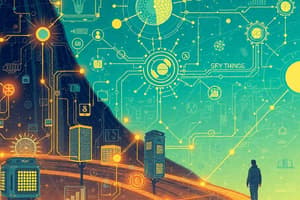Podcast
Questions and Answers
Who is recognized as the 'father of IoT'?
Who is recognized as the 'father of IoT'?
- Norman Joseph Woodland
- Procter & Gamble
- Mario Cardo
- Kevin Ashton (correct)
The simplified IoT architecture consists of three layers.
The simplified IoT architecture consists of three layers.
False (B)
In what year was the first RFID patent granted?
In what year was the first RFID patent granted?
1980
The _____ layer in M2M IoT architecture enables user interaction and application execution.
The _____ layer in M2M IoT architecture enables user interaction and application execution.
Which component is responsible for collecting data in the Sensing Layer?
Which component is responsible for collecting data in the Sensing Layer?
Match the following layers of IoT architecture with their main functions:
Match the following layers of IoT architecture with their main functions:
Which technology was first introduced in 1973 that relates to the IoT concept?
Which technology was first introduced in 1973 that relates to the IoT concept?
What are the components crucial for data collection in IoT?
What are the components crucial for data collection in IoT?
Flashcards
IoT History (brief)
IoT History (brief)
The history of the Internet of Things (IoT) dates back to advancements in barcode (1945) and RFID (1973). It evolved through research and applications, culminating with Kevin Ashton's work on RFID in the 1990s.
M2M Architecture Layers
M2M Architecture Layers
M2M IoT architecture has three key layers: Application, Service, and Network. The layers facilitate user interaction, application support, and communication through various networks.
Simplified IoT Architecture Layers
Simplified IoT Architecture Layers
The modern architecture has four layers: Sensing, Network, Application Support, and Application. They work together to collect, process, and act upon data.
Sensing Layer (IoT)
Sensing Layer (IoT)
Signup and view all the flashcards
Network Layer (IoT)
Network Layer (IoT)
Signup and view all the flashcards
Application Support Layer (IoT)
Application Support Layer (IoT)
Signup and view all the flashcards
Application Layer (IoT)
Application Layer (IoT)
Signup and view all the flashcards
IoT Building Block: Devices
IoT Building Block: Devices
Signup and view all the flashcards
Study Notes
History of IoT
- The history of IoT can be traced back to 1945 with the invention of the barcode by Norman Joseph Woodland.
- The concept of IoT was first introduced in 1973 with the development of RFID (Radio Frequency Identification) technology.
- The first RFID patent was granted to Mario Cardo in 1980.
- In the 1990s, Kevin Ashton, while working for Procter & Gamble, pioneered the practical use of RFID technology for inventory tracking, establishing him as the "father of IoT".
- 2004 onwards, the potential of IoT has been extensively researched and explored, with continuous development of the technology and its applications ongoing.
M2M IoT Architecture
- M2M (Machine-to-Machine) IoT architecture consists of three main layers:
- Application Layer: Enables user interaction and application execution, facilitating communication between applications and APIs. Examples include smart energy, automotive, home, healthcare, and energy applications.
- Service Layer: Holds application support services, including communication, risk management, and application management services.
- Network Layer: Facilitates communication between services and applications through various network technologies like Zigbee, Bluetooth, Wi-Fi, and CoAP.
Simplified IoT Architecture
- The simplified IoT architecture, commonly used today, comprises four layers:
- Sensing Layer (Device Layer): Consists of devices, sensors, actuators, RFID tags, personal entities, and humans, responsible for collecting data from various locations.
- Network Layer: Connects different layers using IoT gateways and local services, enabling communication between data, peer systems, and the application layer.
- Application Support Layer (Service Layer): Provides operational and management support for applications, encompassing software like operating systems, application service systems, resource management systems, and data interchange systems.
- Application Layer: Represents the user interactions with IoT applications, processing real-time data and connecting the physical and digital realms.
Building Blocks of IoT
- Key building blocks of IoT include:
- Devices (End Devices/Nodes): Sensors and hardware, crucial components for data collection.
- Gateways (Local Processing Nodes): Enable networking and facilitate data processing and communication.
- Communication: Connectivity options like Wi-Fi, Bluetooth, and cloud platforms, facilitating data exchange.
- Software: Operating systems, embedded operating systems, various protocols (CoAP, Zigbee), software APIs used in IoT systems.
- Cloud: Data storage systems, essential for storing and managing data collected from IoT devices.
Studying That Suits You
Use AI to generate personalized quizzes and flashcards to suit your learning preferences.




